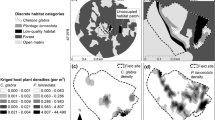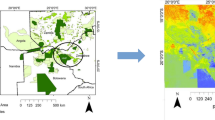Abstract
Animal response to landscape heterogeneity directs dispersal and affects connectivity between populations. Topographical heterogeneity is a major source of landscape heterogeneity, which is rarely studied in the contexts of movement, dispersal, or connectivity. The current study aims at characterizing and quantifying the impacts of topography on landscape connectivity. We focus on ‘hilltopping’ behavior in butterflies, a dispersal-like behavior where males and virgin females ascend to mountain summits and mate there. Our approach integrates three elements: an individual-based model for simulating animal movements across topographically heterogeneous landscapes; a formula for the accessibility of patches in homogenous landscapes; and a graphical analysis of the plots of the simulation-based vs. the formula-based accessibility values. We characterize the functional relationship between accessibility values and landscape structure (referred to as ‘accessibility patterns’) and analyze the influence of two factors: the intensity of the individuals’ response to topography, and the level of topographical noise. We show that, despite the diversity of topographical landscapes, animal response to topography results in the formation of two, quantifiable accessibility patterns. We term them ‘effectively homogeneous’ and ‘effectively channeled’. The latter, in which individuals move toward a single summit, prevails over a wide range of behavioral and spatial parameters. Therefore, ‘channeled’ accessibilities may occur in a variety of landscapes and contexts. Our work provides novel tools for understanding and predicting accessibility patterns in heterogeneous landscapes. These tools are essential for linking movement behavior, movement patterns and connectivity. We also present new insights into the practical value of ecologically scaled landscape indices.
Similar content being viewed by others
References
F.R. Adler B. Nuernberger (1994) ArticleTitlePersistence in patchy irregular landscapes Theor. Popul. Biol. 45 41–75
G.S. Anderson B.J. Danielson (1997) ArticleTitleThe effects of landscape composition and physiognomy on metapopulation size: the role of corridors Landscape Ecol. 12 261–271 Occurrence Handle10.1023/A:1007933623979
M. Baguette S. Petit F. Queva (2000) ArticleTitlePopulation spatial structure and migration of three butterfly species within the same habitat network: consequences for conservation J. Appl. Ecol. 37 100–108 Occurrence Handle10.1046/j.1365-2664.2000.00478.x
V.J. Bakker D.H. Vuren ParticleVan (2004) ArticleTitleGap-crossing decisions by the red squirrel, a forest-dependent small mammal Conserv. Biol. 18 689–697 Occurrence Handle10.1111/j.1523-1739.2004.00149.x
J. Bascompte R.V. Sole (1996) ArticleTitleHabitat fragmentation and extinction thresholds in spatially explicit models J. Anim. Ecol. 65 465–473
J.P. Chardon F. Adriaensen E. Matthysen (2003) ArticleTitleIncorporating landscape elements into a connectivity measure: a case study for the Speckled wood butterfly (Pararge aegeria L.) Landscape Ecol. 18 561–573 Occurrence Handle10.1023/A:1026062530600
P.R. Ehrlich A. Wheye (1988) ArticleTitleHilltopping butterflies revisited Am. Nat. 132 460–461 Occurrence Handle10.1086/284864
H.Y. Fadamiro Y. Henry T.D. Wyatt M.C. Birch (1998) ArticleTitleFlying beetles respond as moths predict: optomotor anemotaxis to pheromone plumes at different heights J. Insect Behav. 11 549–557 Occurrence Handle10.1023/A:1022367430354
L. Fahrig (1992) ArticleTitleRelative importance of spatial and temporal scales in a patchy environment Theor. Popul. Biol. 41 300–314
P. Ferreras (2001) ArticleTitleLandscape structure and asymmetrical inter-patch connectivity in a metapopulation of the endangered Iberian lynx Biol. Conserv. 100 125–136 Occurrence Handle10.1016/S0006-3207(00)00213-5
K. Frank (2004) ArticleTitleEcologically differentiated rules of thumb for habitat network design: lessons from a formula Biodiv. Conserv. 13 189–206
K. Frank (2005) ArticleTitleMetapopulation persistence in heterogeneous landscapes: lessons about the effect of stochasticity Am. Nat. 165 374–388 Occurrence Handle10.1086/428293 Occurrence Handle15729667
K. Frank C. Wissel (1998) ArticleTitleSpatial aspects of metapopulation survival: from model results to rules of thumb for landscape management Landscape Ecol. 13 363–379
K. Frank C. Wissel (2002) ArticleTitleA formula for the mean lifetime of metapopulations in heterogeneous landscapes Am. Nat. 159 530–552 Occurrence Handle10.1086/338991
V. Grimm (1999) ArticleTitleTen years of individual-based modelling in ecology: what have we learned and what could we learn in the future? Ecol. Model. 115 129–148
E.J. Gustafson (1998) ArticleTitleQuantifying landscape spatial pattern: what is the state of the art? Ecosystems 1 143–156
E.J. Gustafson R.H. Gardner (1996) ArticleTitleThe effect of landscape heterogeneity on the probability of patch colonization Ecology 77 94–107
N.M. Haddad K.A. Baum (1999) ArticleTitleAn experimental test of corridor effects on butterfly densities Ecol. Appl. 9 623–633
I. Hanski (1994) ArticleTitleA practical model of metapopulation dynamics J. Anim. Ecol. 63 151–162
I. Hanski J. Alho A. Moilanen (2000) ArticleTitleEstimating the parameters of survival and migration of individuals in metapopulations Ecology 81 239–251
I. Hanski M. Kuussaari M. Nieminen (1994) ArticleTitleMetapopulation structure and migration in the butterfly Melitaea cinxia Ecology 75 747–762
I. Hanski A. Moilanen M. Gyllenberg (1996a) ArticleTitleMinimum viable metapopulation size Am. Nat. 147 527–541 Occurrence Handle10.1086/285864
I. Hanski A. Moilanen T. Pakkala M. Kuussaari (1996b) ArticleTitleThe quantitative incidence function model and persistence of an endangered butterfly metapopulation Conserv. Biol. 10 578–590 Occurrence Handle10.1046/j.1523-1739.1996.10020578.x
I. Hanski O. Ovaskainen (2002) ArticleTitleExtinction debt at extinction threshold Conserv. Biol. 16 666–673 Occurrence Handle10.1046/j.1523-1739.2002.00342.x
I. Hanski C.D. Thomas (1994) ArticleTitleMetapopulation dynamics and conservation: a spatially explicit model applied to butterflies Biol. Conserv. 68 167–180 Occurrence Handle10.1016/0006-3207(94)90348-4
S. Harrison (1989) ArticleTitleLong-distance dispersal and colonization in the bay checkerspot butterfly, Euphydryas editha byensis Ecology 70 1236–1243
S.K. Heinz L. Conradt C. Wissel K. Frank (2005) ArticleTitleDispersal behaviour in fragmented landscapes: deriving a practical formula for patch accessibility Landscape Ecol. 20 83–99
G.R. Hess (1996) ArticleTitleLinking extinction to connectivity and habitat destruction in metapopulation models Am. Nat. 148 226–236 Occurrence Handle10.1086/285922
Levins R. 1970. Extinction. In: Gerstenhaber M. (eds), Some mathematical questions in biology. Am. Math. Soc., pp. 75–107.
W. Lowe (2003) ArticleTitleLinking dispersal to local population dynamics: a case study using headwater salamander system Ecology 84 2145–2154
R. Nathan (2001) ArticleTitleThe challenges of studying dispersal Trends Ecol. Evol. 16 481–483 Occurrence Handle10.1016/S0169-5347(01)02272-8 Occurrence Handle1:CAS:528:DC%2BD3MXnsFGntrY%3D
G. Nève L. Mousson M. Baguette (1996) ArticleTitleAdult dispersal and genetic structure of butterfly populations in a fragmented landscape Acta Oecologica 17 621–626
Opdam P. 1990. Dispersal in fragmented populations: the key to survival. In: Bunce R.G.H. and Howard D.C. (eds), Species Dispersal in Agricultural Habitats. Belhaven Press, pp. 3–17.
G. Pe’er (2003) The Spatial and Behavioral Determinants of Butterfly Dispersal in Topographically Complex Landscapes Department of Life Sciences Ben Gurion University of the Negev Be’er ShevaIsrael
G. Pe’er D. Saltz K. Frank (2005) ArticleTitleVirtual corridors for conservation management Conserv. Biol. 19 1997–2003
G. Pe’er D. Saltz H.-H. Thulke U. Motro (2004) ArticleTitleResponse to topography in a hilltopping butterfly and implications for modelling nonrandom dispersal Anim. Behav. 68 825–839
J.B. Phillips (1996) ArticleTitleMagnetic navigation J. Theor. Biol. 180 309–319 Occurrence Handle10.1006/jtbi.1996.0105
L. Ries D.M. Debinski (2001) ArticleTitleButterfly responses to habitat edges in the highly fragmented prairies of Central Iowa J. Anim. Ecol. 70 840–852 Occurrence Handle10.1046/j.0021-8790.2001.00546.x
J. Roland N. Keyghobadi S. Fownes (2000) ArticleTitleAlpine Parnassius butterfly dispersal: effects of landscape and population size Ecology 81 1642–1653
N.H. Schumaker (1996) ArticleTitleUsing landscape indices to predict habitat connectivity Ecology 77 1210–1225
O. Shields (1967) ArticleTitleHilltopping: An ecological study of summit congregation behavior of butterflies on a southern California hill J. Res. Lepidoptera 6 69–178
Y. Shkedy D. Saltz (2000) ArticleTitleCharacterizing core and corridor use by Nubian ibex in the Negev desertIsrael J. Conserv. Biol. 14 200–206
M.C. Singer C.D. Thomas (1992) ArticleTitleThe difficulty of deducing behavior from resource use: an example from hilltopping in checkerspot butterflies Am. Nat. 140 654–664 Occurrence Handle10.1086/285433
South A.B., Rushton S.P., Kenward R.E. and Macdonald D.W. 2002. Modelling vertebrate dispersal and demography in real landscapes: how does uncertainty regarding dispersal behaviour influence predictions of spatial population dynamics? In: JM B., Kenward R.E. and Hails R.S. (eds), Dispersal Ecology: The 42nd Symposium of the British Ecological Society held at the University of Reading, 2–5 April 2001. Blackwell Sciencepp. 327–349.
O.L. Sutcliffe V. Bakkestuen G. Fry O.E. Stabbetorp (2003) ArticleTitleModelling the benefits of farmland restoration: methodology and application to butterfly movement Landscape Urban Plan. 63 15–31
W.T. Tennent (1995) ArticleTitleField observations of the ‘hilltopping’ phenomenon in North-West Africa - and an introduction to ‘Ravining’ (Lep.: Rhopalocera) Entomologists’ Record 106 57–67
C.D. Thomas (2000) ArticleTitleDispersal and extinction in fragmented landscapes Proc. Roy. Soc. Lond. B 267 139–145 Occurrence Handle1:STN:280:DC%2BD3c7ltVGhtA%3D%3D
L. Tischendorf D.J. Bender L. Fahrig (2003) ArticleTitleEvaluation of patch isolation metrics in mosaic landscapes for specialist vs. generalist dispersers Landscape Ecol. 18 41–50 Occurrence Handle10.1023/A:1022908109982
L. Tischendorf L. Fahrig (2000) ArticleTitleOn the usage and measurement of landscape connectivity Oikos 90 7–19 Occurrence Handle10.1034/j.1600-0706.2000.900102.x
P. Turchin (1998) Quantitative Analysis of Movement: Measuring and Modeling Population Redistribution in Animals and Plants Sinauer Associates Sunderland
C.C. Vos J. Verboom P.F.M. Opdam C.J.F. Ter Braak (2001) ArticleTitleToward ecologically scaled landscape indices Am. Nat. 183 24–41
H.G. Wallraff (2000) ArticleTitleSimulated navigation based on observed gradients of atmospheric trace gases (models on pigeon homing, part 3) J. Theor. Biol. 205 133–145 Occurrence Handle10.1006/jtbi.2000.2052 Occurrence Handle1:CAS:528:DC%2BD3cXktVKmsbk%3D Occurrence Handle10860706
P.O. Wickman (1988) ArticleTitleDynamics of mate-searching behavior in a hilltopping butterfly, Lasiommata megera (L.): the effect of weather and male density Zool. J. Linn. Soc. 93 357–377
T. Wiegand K.A. Moloney J. Naves F. Knauer (1999) ArticleTitleFinding the missing link between landscape structure and population dynamics: a spatially explicit perspective Am. Nat. 154 605–627 Occurrence Handle10.1086/303272 Occurrence Handle10600609
Wiens J.A. 2001. The landscape context of dispersal. In: Clobert J., Danchin E., Dhondt A.A. and Nichols J.D. (eds), Dispersal: Individual, Population, and Community. Oxford University Press, pp. 96–109.
J.A. Wiens N.C.V. Stenseth R.A. Ims (1993) ArticleTitleEcological mechanisms and landscape ecology Oikos 66 369–380
R. Wiltschko W. Wiltschko (2003) ArticleTitleAvian navigation: from historical to modern concepts Anim. Behav. 65 257–272 Occurrence Handle10.1006/anbe.2003.2054
T. Yamanaka S. Tatsuki M. Shimada (2003) ArticleTitleAn individual-based model for sex-pheromone-oriented flight patterns of male moths in a local area Ecol. Model. 161 35–51 Occurrence Handle10.1016/S0304-3800(02)00291-0 Occurrence Handle1:CAS:528:DC%2BD3sXhtV2ktL8%3D
Author information
Authors and Affiliations
Corresponding author
Rights and permissions
About this article
Cite this article
Pe’er, G., Heinz, S.K. & Frank, K. Connectivity in Heterogeneous Landscapes: Analyzing the Effect of Topography. Landscape Ecol 21, 47–61 (2006). https://doi.org/10.1007/s10980-005-1622-7
Received:
Accepted:
Issue Date:
DOI: https://doi.org/10.1007/s10980-005-1622-7




